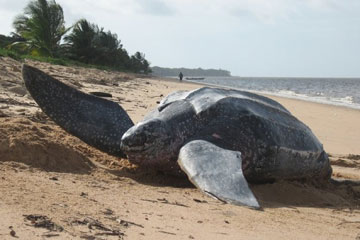Discovery of new leatherback migration route may help save species
Discovery of new leatherback migration route may help save species
Jeremy Hance, mongabay.com
July 15, 2008
|
|
Scientists have discovered a new migration route for the world’s largest turtle, the leatherback. The route takes the 2,000-pound marine turtle from the Playa Grande beaches in Costa Rica to an area deep in the South Pacific.
The Leatherback turtle is listed as Critically Endangered by the IUCN and the Pacific population has proven even more threatened than the Atlantic with a 90 percent population drop in just twenty years. The discovery of this new route has important conservation implications and could provide a lifeline for the Pacific population.
“Given that the turtles seem to move in a predictable way from the nesting beach through the equatorial region from roughly February through April, we could potentially suspend fishing in certain areas while the leatherbacks are passing through that part of the eastern Pacific,” George Shillinger said, a member of the large team who conducted the study and a doctoral candidate at Stanford.
 leatherback camoflauging nest in Galibi, Suriname. Photo by Tiffany Roufs |
Of great importance for conservation is that the route is narrow and used consistently, the researchers note. Unlike other sea turtles, and even other leatherback populations, which disperse widely across their migration routes.
The turtles’ goal is the South Pacific Gyre. Scientists don’t know yet why they choose this area, but presumably they are looking for jellyfish. The area is unfortunate for the turtles due to the presence of a large-scale longline tuna fishery. Schillinger believes this fishery may be one of the reasons for the leatherbacks plummeting population in the Pacific: marine turtles are caught by longline fisheries as bycatch.
“What often happens with longliners is that it is just inconvenient to hassle with a turtle and they don’t want to lose the hook, either, so what people will do is just cut the flipper off with a machete and just send the turtle away to die,” Schillinger explained. “A turtle without a front flipper is a dead turtle.”
With transnational agreements the entire migration corridor could be protected, including the feeding grounds at the South Pacific Gyre, during the months when the turtles are on the move. “I wouldn’t write these turtles off,” Schillinger said. “If we can inform and change fisheries practices with sound science and policy, then hopefully there will be a chance to conserve turtles and the ecosystems that they occupy.” He added, “these turtles could be a really awesome flagship for conservation.”
The study is part of the Tagging of Pacific Predators (TOPP) program. Along with leatherbacks, the study has tagged other oceanic predators such as the bluefin tuna, black-footed albatross, elephant seal and several species of shark including, the mako, the salmon, and the great white. TOPP is part of the Census of Marine Life, which recently announced its halfway mark by registering 120,000 species online.